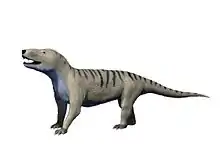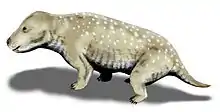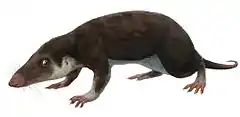Probelesodon
Probelesodon is an extinct genus of chiniquodontid cynodonts. Fossils have been found from Argentina and Brazil of Triassic age.
| Probelesodon | |
|---|---|
 | |
| Skull cast, Museum of Evolution of Polish Academy of Sciences | |
| Scientific classification | |
| Kingdom: | Animalia |
| Phylum: | Chordata |
| Clade: | Therapsida |
| Clade: | Cynodontia |
| Family: | †Chiniquodontidae |
| Genus: | †Probelesodon Romer, 1969 |
| Species | |
| |
History of discovery

Specimens were first discovered from the Chañares Formation in La Rioja Provence, Argentina that date back to the Anisian stage of the early Middle Triassic. A new species, P. sanjuanensis, was named in 1996 on the basis of a skull found from the Ischigualasto Formation. This extends the temporal range of Probelesodon into the Carnian stage of the Late Triassic. The occurrence of the genus in these strata suggests that it also existed during the deposition of the Los Rastros Formation, which also outcrops in the same area as the localities where fossils have been found, although specimens have yet to be found from this formation. The presence of the genus in the Ischigualasto Formation is restricted to the earlier strata, becoming completely extinct soon after along with the last of the carnivorous cynodonts in the area. This has been taken as evidence for the gradual replacement of therapsid fauna with the later mainly archosaur-dominated faunas of the Late Triassic. Evidence from the Chañares Formation also seems to support this faunal transition.[1]
Species
The type species of Probelesodon is P. lewisi from the Chañares Formation. This species is the best known as many relatively complete specimens have been found. A long secondary palate distinguishes it from other closely related genera such as Belesodon. The postcanines are multicuspidate and the main cusps curve back. One species, P. sanjuanensis, differs from other species of Probelesodon by such characteristics as a highly arched zygomatic arch and the presence six postcanines.[2] Another species, P. kitchingi was named in 1982 from material found from Rio Grande do Sul, Brazil.[3] P. minor is similar in appearance to the type species and has been found from the same formation. It differs mainly in size, being about half the length of the type species. This size difference is too great to be considered sexual dimorphism.[4] The close similarities between all four species have led to recent suggestions that they are synonymous with one another. It has even been suggested that the entire genus is synonymous with Chiniquodon theotonicus.
References
- Romer, A. S. (1969). The Chanares (Argentina) Triassic reptile fauna. V. A new chiniquodontid cynodont, Probelesodon lewisi - cynodont ancestry. Breviora 333:1-24.
- Martinez, R. N. and Forster, C. A. (1996). The skull of Probelesodon sanjuanensis, sp. nov., from the Late Triassic Ischigualasto Formation of Argentina. Journal of Vertebrate Paleontology 16:2:285-291.
- Teixeira, A. M. S. (1982). Um novo cinodonte carnivore (Probelesodon kitchingi sp. nov.) do Triassico do Rio Grande do Sul, Brasil. Comunicações do Museu de Ciências da PUCRS 24:1-31.
- Romer, A. S. (1973). The Chanares (Argentina) Triassic reptile fauna. XVIII. Probelesodon minor, a new species of carnivorous cynodont; family Probainognathidae nov. Breviora, 401:1-4.






